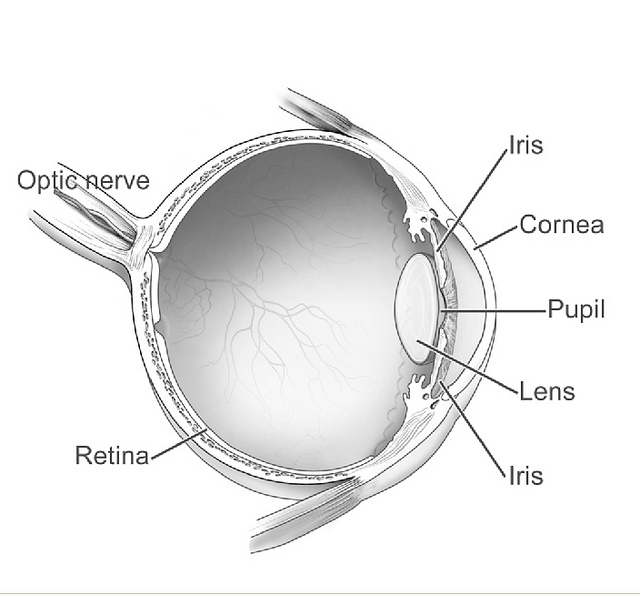|
Salmon Patch Of Hutchinson
Hutchinson's patch (or salmon patch of Hutchinson) is a dull orangish-pink area (generally without clear boundaries) on the cornea, most often found at the periphery of the cornea. The sign is an indication of interstitial (or parenchymatous) keratitis, causing corneal neovascularisation Corneal neovascularization (CNV) is the in-growth of new blood vessels from the pericorneal plexus into avascular corneal tissue as a result of oxygen deprivation. Maintaining avascularity of the corneal stroma is an important aspect of corneal .... It is named after the English physician Jonathan Hutchinson (1828–1913). References Medical signs Eye diseases {{eye-stub ... [...More Info...] [...Related Items...] OR: [Wikipedia] [Google] [Baidu] |
Cornea
The cornea is the transparent front part of the eye that covers the iris, pupil, and anterior chamber. Along with the anterior chamber and lens, the cornea refracts light, accounting for approximately two-thirds of the eye's total optical power. In humans, the refractive power of the cornea is approximately 43 dioptres. The cornea can be reshaped by surgical procedures such as LASIK. While the cornea contributes most of the eye's focusing power, its focus is fixed. Accommodation (the refocusing of light to better view near objects) is accomplished by changing the geometry of the lens. Medical terms related to the cornea often start with the prefix "'' kerat-''" from the Greek word κέρας, ''horn''. Structure The cornea has unmyelinated nerve endings sensitive to touch, temperature and chemicals; a touch of the cornea causes an involuntary reflex to close the eyelid. Because transparency is of prime importance, the healthy cornea does not have or need blood vessels with ... [...More Info...] [...Related Items...] OR: [Wikipedia] [Google] [Baidu] |
Interstitial Keratitis
Interstitial keratitis (IK) is corneal scarring due to chronic inflammation of the corneal stroma. Interstitial means space between cells i.e. corneal stroma which lies between the epithelium and the endothelium. Keratitis means corneal inflammation. Signs and symptoms Acutely, early symptoms include a painful, photophobic, red watery eye. This is due to active corneal inflammation resulting in vascular invasion and stromal necrosis which can be diffuse or localized. This causes the pinkish discoloration of what was a clear transparent normal corneal tissue (called '' Salmon patch of Hutchinson''). Such vascularization is likely to result in blurring of vision secondary to corneal stromal scarring, the presence of ghost vessels, and thinning of the cornea, especially if it involves the visual axis. Cause By far the most common cause of IK is syphilitic disease. However, there are two possible causes of the corneal inflammatory response: an infection and/or an immunological re ... [...More Info...] [...Related Items...] OR: [Wikipedia] [Google] [Baidu] |
Corneal Neovascularisation
Corneal neovascularization (CNV) is the in-growth of new blood vessels from the pericorneal plexus into avascular corneal tissue as a result of oxygen deprivation. Maintaining avascularity of the corneal stroma is an important aspect of corneal pathophysiology as it is required for corneal transparency and optimal vision. A decrease in corneal transparency causes visual acuity deterioration. Corneal tissue is avascular in nature and the presence of vascularization, which can be deep or superficial, is always pathologically related. Corneal neovascularization is a sight-threatening condition that can be caused by inflammation related to infection, chemical injury, autoimmune conditions, immune hypersensitivity, post-corneal transplantation, and traumatic conditions among other ocular pathologies. Common causes of CNV within the cornea include trachoma, corneal ulcers, phylctenular keratoconjunctivitisrosacea keratitis interstitial keratitissclerosing keratitis chemical burns, an ... [...More Info...] [...Related Items...] OR: [Wikipedia] [Google] [Baidu] |
Jonathan Hutchinson
Sir Jonathan Hutchinson (23 July 1828 – 23 June 1913), was an English surgeon, ophthalmologist, dermatologist, venereologist, and pathologist. Life He was born in Selby, Yorkshire, of Quaker parents and educated in the local school. Then he was apprenticed for five years to Caleb Williams, an apothecary and surgeon in York. He entered St Bartholomew's Hospital in London, and became a member of the Royal College of Surgeons in 1850 (and a fellow in 1862), and rapidly gained reputation as a skillful operator and a scientific inquirer. While a student, Hutchinson chose a career in surgery from 1854 on, under the influence and help of his mentor, Sir James Paget (1814–99). In 1851, he studied ophthalmology at Moorfields and practised it at London Ophthalmic Hospital. Other hospitals where he practised in the following years were the Lock Hospital, the City of London Chest Hospital, the London Hospital, the Metropolitan Hospitals, and the Blackfriars Hospital for Diseases of ... [...More Info...] [...Related Items...] OR: [Wikipedia] [Google] [Baidu] |
Medical Signs
Signs and symptoms are the observed or detectable signs, and experienced symptoms of an illness, injury, or condition. A sign for example may be a higher or lower temperature than normal, raised or lowered blood pressure or an abnormality showing on a medical scan. A symptom is something out of the ordinary that is experienced by an individual such as feeling feverish, a headache or other pain or pains in the body. Signs and symptoms Signs A medical sign is an objective observable indication of a disease, injury, or abnormal physiological state that may be detected during a physical examination, examining the patient history, or diagnostic procedure. These signs are visible or otherwise detectable such as a rash or bruise. Medical signs, along with symptoms, assist in formulating diagnostic hypothesis. Examples of signs include elevated blood pressure, nail clubbing of the fingernails or toenails, staggering gait, and arcus senilis and arcus juvenilis of the eyes. Indicatio ... [...More Info...] [...Related Items...] OR: [Wikipedia] [Google] [Baidu] |


